#blood money 1933
Explore tagged Tumblr posts
Text
Why Emesis Blue Medic should be taken off the Gravel War Battlefield.
My overall Em Blue theory is that it’s a shared nightmare, so keep that in mind for this post.
So we know Dr Ludwig has been diagnosed with Schizophrenia by somebody at BLU. The reason we know this is because he gave Scout the same medicine that he’s been taking, which you wouldn’t do if you had two different issues going on.
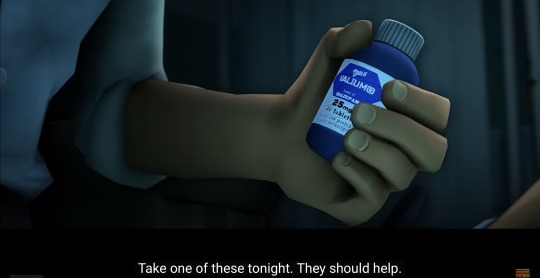

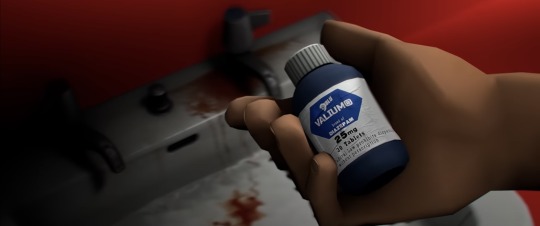


If you were Scout and your doctor friend was addicted to this medicine, you wouldn’t want to get addicted yourself. In fact, I wouldn’t be surprised if Scout theorizes that the medicine is part of the problem.
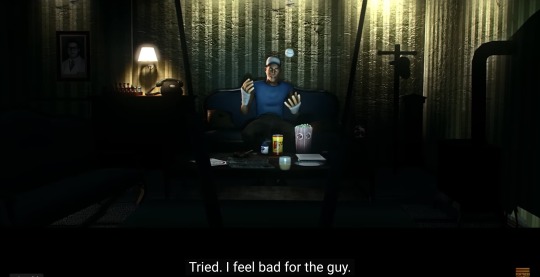
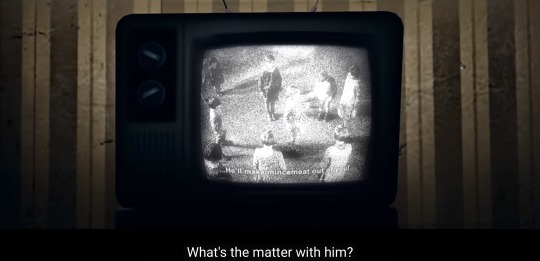
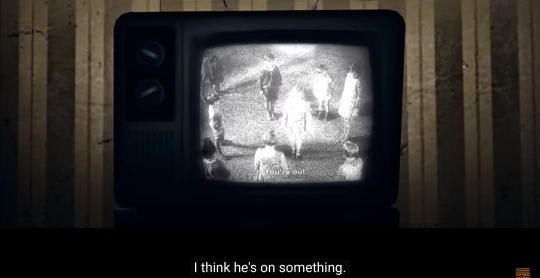
So here’s my theory on what mental health problem is plaguing BLU Medic:
Because he was roughly 6 when the N*zis took power in 1933 and Jewish, Fritz had a lot of trauma from a young age. He developed DID, formerly known as Multiple Personality Disorder [it can only develop from childhood trauma]. His parents and doctors were limited in what they could do because of the state of the country; they also thought his hallucinations of other personalities were imaginary friends.
When he escaped to America as an adult, he decided to join BLU in the hopes that other mercenaries would be willing to go fight against Germany in the war. But then the first respawn failures happened, and he got roped into being an “expert” on the issue.
Spy’s Disguise gave us a brief window into what was happening to the doctor during the respawn crisis.


He hasn’t been sleeping well. He’s got an exposed cut on his face, a five o’clock shadow, and bags under his eyes.
He didn’t speak or blink for any of the scenes he was in, which was off putting to Engineer. He even showed them what was wrong using a VHS, not his words.
Overall, he seems aloof and unapproachable, which is different to how he acted in Em Blue.
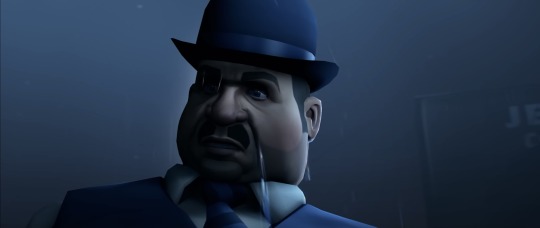
We know Jules Archibald must be a hack since Soldier and Spy had a nightmare where he’s callously letting people die for money. If he’s too posh to defend himself like he was in Spy’s perspective, he’s got to be too posh to deal with respawn failure gore.
But that wouldn’t stop him and his crew from holding Medic to a high standard when it came to his work, even if they didn't really want to spend money to fix the problem. I imagine the Administrator was the one that had to “motivate” them to allocate funds, and it would take her a while to get fed up.
So in the meantime, Ludwig developed a new, scarier personality to help him deal with Jules and new respawn failure trauma.
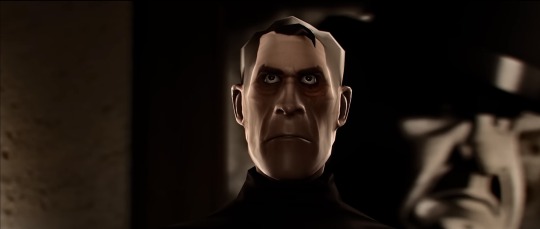
He was the one in control when CyberSpy was examined, and when he was given the bad news about his condition.
We know the doctor still doesn't understand his condition because of the nightmare versions of his other personalities.
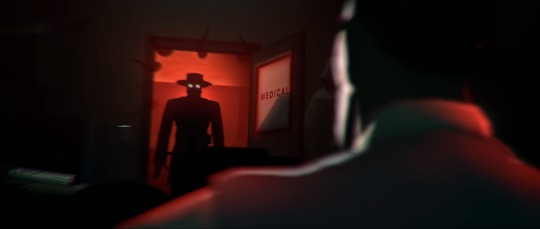
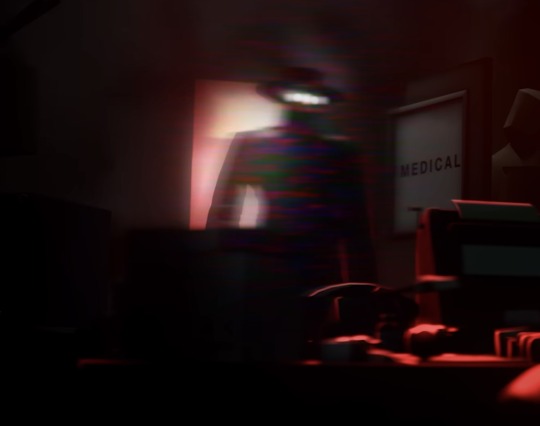
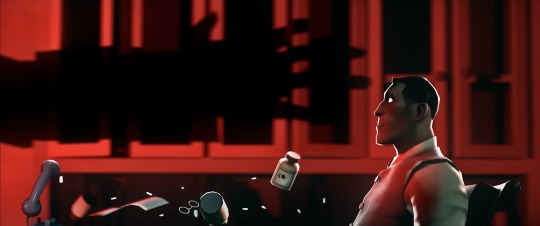
This is the nightmare version of the unblinking, mute personality from the funeral. But he’s not the only personality that Fritz is afraid of.
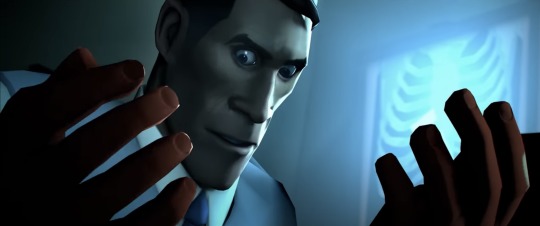
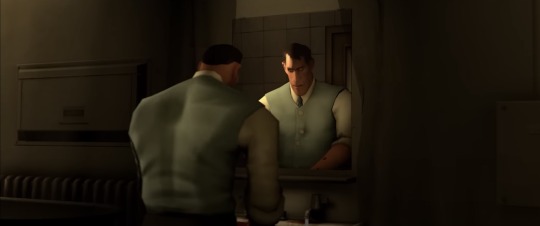
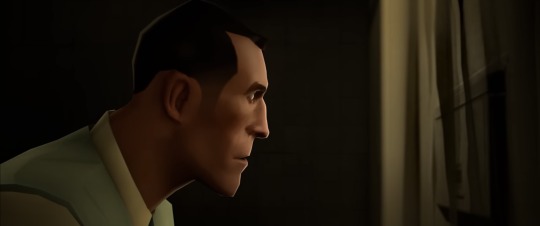
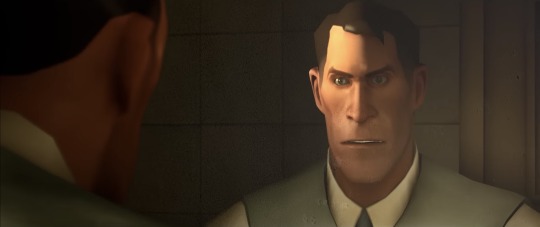
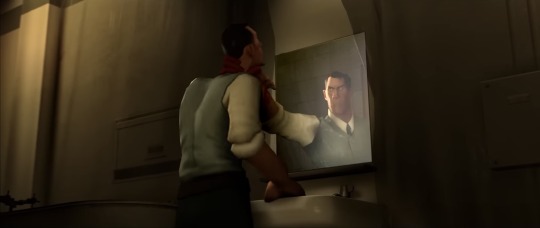


This hallucination gives us more insight into how the doctor views his other personalities. 1. They are trying to trick him and other people. Whichever one this nightmare is based off of is good at pretending to be him.
2. They hate him. He woke up with blood on his hands and no memory of why. The nightmare got angry that he tried to wash the blood off himself. It didn’t hesitate to hurt him.
3. They love violence, and they want to hurt him. This one choked him out and slammed his head into the mirror. And again, he woke up with blood on his hands.
Him unknowingly killing Scout’s Ma and kidnapping the poor guy happened because he’s afraid that these personalities want to do that. He’s afraid that they’re plotting something and biding their time, Em Blue is the manifestation of what he thinks they’re up to.
The plague doctor was reaching towards him like it was going to be fake nice, despite all of its terrifying features. He thinks that one is trying to lull him into a false sense of security.
He’s wrong about them, and we have proof. We have the actual personality that the mirror monster is based off of, and a long scene with him in control.
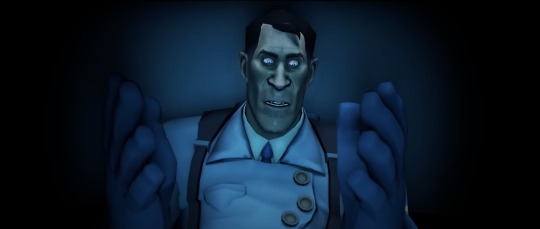
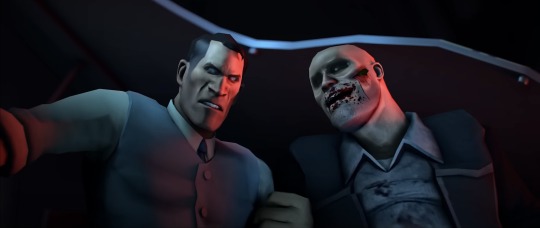


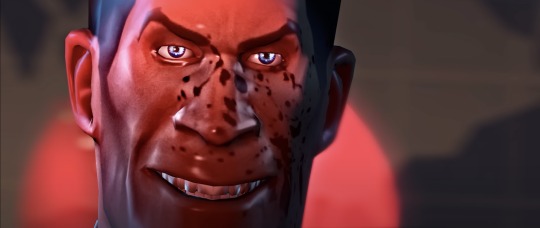
This is the personality that developed to deal with RED mercs on the battlefield. That’s why he’s so good at fighting and acts so terrifying.
Now imagine for a moment that you black out during a fight, and when you come to your team is freaking out over you. They say you started beating the RED team senseless, with a terrifying grin that nobody has seen from you before. You don’t remember any of it, and unfortunately it’s only the first of many times this will happen.
That’s Dr Ludwig’s perspective. He doesn’t know what they want. He doesn’t know what they are or how to get rid of them. They keep appearing in the corner of his office or his room, if you watch him talk to Scout in his MedBay, he keeps looking around like he expects another person to be there. He just wants it to stop, so he starts relying on Valium as a crutch.
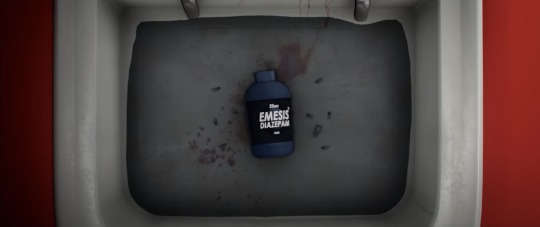
The bottle reveal is an interesting scene to me, because Emesis Diazepam horrifies the doctor. It must be something he knows is dangerous, and he’d never take knowingly.
Here are some symptoms of long term Valium/Diazepam abuse
Persistent drowsiness
Confusion
Memory loss
Fatigue
Dizziness
Blood in urine/feces
Depression
Anxiety
Tremors
Sleeping problems
Nightmares
Hallucinations
Seizures
Here are the overdose symptoms:
Coma [can still breathe]
Bluish lips and fingernails
Blurred/double vision
Slowed/stopped breathing
Confusion
Depression
Dizziness
Drowsiness
Excitability
Hiccups
Rapid eye movement
Rash
Stomach is upset/pained
Tiredness
Tremors
Uncoordinated movement and weakness
I think the bottle reveal is meant to be a wake up call about the Valium addiction. Maybe the other personalities know he should stop taking it, we do see the quiet one standing behind him afterwards.
DID personalities develop to protect a person from their trauma and keep them safe. Sometimes these personalities can be dangerous because they believe that they are demons, evil, or that destroying the host body will just send them back to their own. People wake up parked on bridges and in other odd places because another personality took control then switched back.

But in every scene where we get to see the others in control, they appear to be trying to help Fritz, not make things worse. The quiet one was trying to keep him safe from Spy and the people at BLU that made him a scapegoat. The violent one was attacking the Engineers to try and save both Medic and Scout, and probably tried to take control at Scout’s house so he could deal with BLU Ma’s body instead.
When the ambulance crashed into the telephone pole, that was because the quiet one over exerted himself and blacked out. But remaining parked outside of Scout’s house and waking up may well have happened because of the Valium abuse. The medicine is causing more symptoms that overlap with DID, and exacerbating the distrust that Fritz feels towards the others.
This doesn’t make him a bad guy, he doesn’t know what he’s doing to himself or that the others are trying to help him. The quiet one is terrifying, and seeing him in the corner of your room would get on your nerves. Blacking out and being told about actions you don’t remember doing would be terrifying, and I don’t blame him for assuming the personalities are malicious.
Maybe it would be better for BLU Medic to keep working as BLU since it’s become home, but not as a battle Medic. First he needs to reconcile with the others and understand what they are trying to do. Then they need to work together to decide whether he should retire or stay at the familiar base. But he’s having too many issues to be fighting other mercenaries.

The Spies and RED Medic that looks exactly like him are just going to confuse matters more, whether they know it or not. They gotta get another BLU Medic to fight on the field, this can’t go on.
#tf2#emesis blue#character analysis#sad lad hours#emesis blue medic#emesis blue theory#Angst#medical symptoms#Not a psychiatrist
93 notes
·
View notes
Note
I love the Agatha Christie question!
Who are your HP/Twilight faves in the Christie universe? (Who’s the opportunist who knows too much and dies for it? Who’s the conman killer who courts the girl to avoid suspicion? Who’s just trying to take a holiday and gets caught-up in a murder? Who are the dynamic mystery-solving duo who realize they are in love by the end of the novel? etc.).
I mean, that is kind of what The Man Who Would Be King (and secret fic) (both cowritten with @theoriginalcarnivorousmuffin) have already become. We have our murder victim, Alphard, a very rich man with a colorful family, and possibly his sister, we have our unlikely detectives in Voldemort, Lily Potter, and Alphard himself. It may not be the center of the story but it's a large part of it.
In other words my answer for Harry Potter would somehow spoil all my present and future fics so I won't.
As for the Twilight version...
I vote we do it wealthy dysfunctional family style, it's most natural.
A patriarch is poisoned
Carlisle Cullen, a very wealthy man with powerful enemies, nonetheless dear to those around him and blessed with more friends than most, is found dead in his office one morning. Cause of death? Murder.
The police, caught on the detail that Dr. Cullen was a vampire and vampires are real, what the fuck is this on the doctor's autopsy table and is he going to wake up again and drink all our blood?, are little use in the investigation. Scotland Yard is soon brought in, and using Chief Swan's connections with the family they get a better picture of Dr. Cullen's life.
His family wasn't looking to inherit him anytime soon, as he was immortal. None of them were having money troubles however, all were independently wealthy.
He had made enemies of a thousand-year-old clan of powerful vampires, who on hearing that his murder is being investigated like this get very upset. Supposedly the victim lived with them in his youth (and inspector Craddock cries when he learns the timeline for this murder goes back to the 1600s. Are they going to have to bring historians in on this murder??), he might have known something
Oh what's that? The victim had a whole network of friends across the globe, who are all killers, and he knew everyone's secrets? ... do we have the budget to investigate this?
The victim was also living next to a tribe of magical shapeshifting wolves evolved specifically to kill his kind. They liked him best and had a line in their treaty that "he dies last". Not sure what to do with this information
Rosalie Hale missing person case from 1933 solved: Carlisle Cullen adopted her. Was she recognised, did someone piece it together, and was Carlisle killed in retribution?
The victim lived a fake life of fake papers. Could be important, except it's the most normal thing about this case.
The police wonder how this man didn't get murdered sooner, and are stretched so thin the investigation is going slowly.
So, Renesmee gets to be our plucky detective du jour, as she decides to see if she can help. Surely there is no harm in her poking around, and she's well liked around the vampire world so there might be answers she can get that human police can't, partly because policemen keep getting eaten.
She slowly narrows it down to the horrible realization that it was someone in the family, and she learns terrible things.
Jasper Hale wasn't Jasper Hale at all! He was a friend of Jasper's in the newborn army who wanted a new life, and who in the wake of Jasper's suden and unexpected death assumed his identity. He had Peter bite his entire face so he'd be scarred like Jasper had been, and vouch for this blond vampire most definitely being Jasper Hale. Peter later had to die because he Knew Too Much, and so did Charlotte, regrettably. Fake Jasper did however not kill Carlisle.
Edward seems a prime suspect, he is an angry and resentful young man who acts out. Everyone thinks he did it, and that Bella should certainly marry Jacob, the safer option. Much upheaval is had, however, once Renesmee is able to clear Edward's name and he meaningfully links arms with Bella. They sail off into the sunset with their inheritance.
Rosalie is a beautiful, cold, intimidating woman, the femme fatale sort who's surely conniving. It's a bit of a mystery why she married that poor fool Emmett, but it's clear to all she doesn't love him. No clear motive from her, other than the money she would inherit, but she's just so suspicious. Her alibi is ambiguous, she claims she was with Esme and Emmett but what if Esme and Emmett are lying to protect their daughter and wife? Superintendent Battle wonders about that.
Renesmee is at a loss.
And then she realizes that it's not Rosalie who acts like she doesn't love Emmett, it's Emmett who acts like he doesn't love her! And Esme's grieving widow act is just that, it's an act!
Renesmee realizes that Emmett and Esme are lovers, and killed Carlisle together. Esme committed it while Emmett tricked Rosalie into giving her an alibi. Renesmee realizes this once she has a "But Rosalie couldn't have seen Esme from that angle!" moment.
The plan was too pin Rosalie for the murder, see her hanged, and then in due time the mourning widowers would marry, happily entitled to all the money they couldn't have touched if they'd divorced. Also Rosalie was Catholic so she wouldn't have agreed to a divorce.
The two lovers are confronted, and Esme pulls out a tiny pearl-studded gun from her shoe, says "We tried, my love. I regret nothing" before shooting first Emmett, then herself.
#agatha christie#twilight#twilight renaissance#twilight meta#my fic#the carnivorous muffin#the carnivorous muffin fic#the man who would be king#secret fic#renesmee cullen#cullens#jasper hale#rosalie hale#emmett cullen#esme cullen#carlisle cullen
61 notes
·
View notes
Text
by William P. Barr
Reading the report issued last month by Columbia University’s Task Force on Antisemitism, one could be forgiven for thinking that it describes the University of Heidelberg circa 1933. It contains accounts of observant Jews being harassed and assaulted, and open calls for the murder of Jews. But no, this is not Nazi Germany. This is the Upper West Side of Manhattan in 2024. There—in one of the nation’s most elite enclaves of higher learning—the oldest hatred is alive and well, gussied up in academic robes.
The admittedly “serious and pervasive” antisemitic incidents detailed by the report are disturbing. Even more troubling is the extent to which Columbia faculty and administrators were complicit in the problem. One instructor kicked off a class in the Master of Public Health program with a discussion of the Jewish “capitalists” who “laundered” their “dirty money” and “blood money” through donations to the university. Others silenced Jewish students in class discussions of the Holocaust and Israel. Still others moved class sessions and office hours to Columbia’s “Gaza Solidarity Encampment,” where Jewish students were routinely threatened and physically attacked.
For their part, campus demonstrators made no attempt to conceal their hatred of Jews. In fact, they made a public spectacle of it. A video cited by the report shows demonstrators stealing an Israeli flag from a Jewish student and assaulting him as he tried to stop them from setting it on fire. It shows demonstrators repeatedly shouting “Go back to Poland” at Jewish students as they walked across campus. One leader of the encampment proudly boasted, “Be grateful that I’m not just going out and murdering Zionists. . . I feel very comfortable calling for those people to die.” Still, the same university that offers hours of training on “microaggressions” refused to acknowledge decidedly macro-aggressive attacks on Jews.
While all this was happening, administrators either minimized or denied the problem. One member of the Office of Diversity told a student that if the antisemitic incidents she observed made her feel unsafe, she should leave campus. Another administrator told individual students that they were the “only student” who had complained about antisemitism before referring each for mental health counseling.
The gaslighting is astonishing. Moreover, the report’s key recommendation—more training on what constitutes antisemitism—misses the point.
Antisemitism isn’t borne of ignorance at Columbia. Antisemitism is taught at Columbia. Discrimination—now reconceptualized as “intersectionality”—has become the ideological touchstone of the university. It is the subject of training programs, celebrated in academic centers, studied in labs, and baked into departmental mission statements. Under this theory, the world is divided into oppressor and victim classes based on racial, ethnic, and gender identity. And in this system of power and subordination, Jews are the ultimate oppressors. As one Columbia student leader put it, “white Jewish people are today and always have been the oppressors of all brown people.”
So the problem is not, as the report suggests, an “absence of clarity” about what constitutes antisemitism. It’s that antisemitism now lies at the ideological heart of the university, smuggled in through postmodern critical theory. It has been nurtured in faculty lounges and classrooms for decades. Now it is on public display for the entire world to see.
This hatred is a danger to all members of the Columbia community, as it will not—and has not—stopped with Jews.
In April, an angry mob consisting primarily of Columbia students, alumni, and even faculty, overran the university’s historic Hamilton Hall in the name of “intifada.” Four janitors were working in the building at the time, cleaning up after students and faculty. The rioters held two of the men, one African American and the other Latino, against their will and physically assaulted them. (My law firm represents the two workers.)
All of this darkly mirrors the violent convulsions that wracked Columbia during the late 1960s, when I was an undergraduate there. Then, as I recount in my recent memoir, it was Students for a Democratic Society that was calling for a revolution. Mainly white and affluent, the demonstrators seemed to have done pretty well for themselves under the existing democratic system. But what they lacked in intellectual coherence, they more than made up for in violent zeal. They took over buildings, rioted, and provoked violent confrontations with the police, all while campus administrators, with a few notable exceptions, remained supine.
By the time the university was forced to take action against the rioters, it was too late. The message had been sent. Moderates, conservatives, and the politically undecided chose to pursue their education elsewhere. Radicals and revolutionaries were welcome on the Columbia faculty. And the very mission of the university changed from the pursuit of truth and knowledge to activism and social transformation.
The antisemitism that is convulsing Columbia is the consummation of the ideological drift and mission creep that began at the university in the 1960s. What was initially a crude cry for revolution in the riots of 1968 now finds expression in the academic jargon of intersectionality. But violence is the inevitable end of a theory that views our democratic institutions as systems of subordination. And antisemitism is the impulse that is unleashed by the intersectional taxonomy of oppressors and victims.
It will take more than a cleanup crew to remove the stain of antisemitism at Columbia. It will take principled leaders with moral courage and ramrod spines, both of which seem to be in short supply. In the absence of those leaders, the victims of discrimination will have to rely on our legal and judicial institutions to protect the civil rights that Columbia University has once again surrendered to a baying mob.
#columbia university's taskforce on antisemitism#columbia university#antisemitism#gaza solidarity encampment#gaslighting
30 notes
·
View notes
Text
Occupied Palestine ("Israel"), is quite literally beating the dead horse that is the "Hamas" or "Oct. 7 2023" arguments. Which should not be surprising to anyone as the U.S., U.K., Canada, France, Spain and Germany have all done similar when it came to talking about the people they have committed Genocide and/or war crimes against. Notably the U.S.'s long list of people including (but not limited to);
Iraqis, Afghans, Haitians, Laotians, Vietnamese, Koreans, Japanese, Puerto Ricans, Black Americans and Africans, Mexicans, and countless of Indigenous people of Turtle Island/American.
The Third Reich did the same with their propaganda to push and encourage men and women to help with the war and genocide from 1933-1945. In reality, it's no surprise that Occupied Palestine's legal team is continuing in the footsteps of Daddy Genocidal Joe and Mommy Blood Money Royalty.
Occupied Palestine is continuing to shove their own feet into their mouths, and most of the world has had enough of them saying the same lies over and over again. However, some people are more focused on punishing them before freeing Palestine.
Remember, we have to walk before we can run. In WW2 the primary focus during the war was stopping the Axis powers, then the focus shifted to pushing them once they flew the white flag.
We have to stop the genocide before we punish it or else Palestine will continue to suffer and will suffer even more.
Take baby steps. Listen to the people of Palestine, support South Africa and Yemen in their efforts of stopping the genocide. We have to walk before we can run.
From the river
to the sea,
Palestine will be free 🕊️
Note: the order of countries is supposed to be in a rough historical order
#palestine#free palestine#free gaza#south africa#yemen#fuck israel#fuck zionists#anti zionisim#anti zionism is not antisemitism#human rights#genocide#fuck the usa#fuck the uk#fuck germany#the war is not over#from the river to the sea palestine will be free
66 notes
·
View notes
Text

References & Footnote
Abraham, R. C. 1933. The Tiv people. Lagos: Government Printer.
Afigbo, A. E. 1971. ‘The Aro of southeastern Nigeria: a socio-historical analysis of legends of their origins’, African Notes 6: 31–46.
Aglietta, M. and A. Orle´an (eds.) 1995. Souverainete´, le´gitimite´ de la monnaie. Paris: Association d’E´ conomie Financie‘re (Cahiers finance, e´thique, confiance).
Akiga Sai, B. 1939. Akiga’s story; the Tiv tribe as seen by one of its members. Translated and annotated by Rupert East. London: Published for the International African Institute by the Oxford University Press.
Akiga Sai, B. 1954. ‘The “descent” of the Tiv from Ibenda Hill’ (translated by Paul Bohannan), Africa: Journal of the International African Institute 24: 295–310.
Akin, D. and J. Robbins 1998. An introduction to Melanesian currencies: agencies, identity, and social reproduction, in D. Akin and J. Robbins (eds.), Money and modernity: state and local currencies in Melanesia, 1–40. Pittsburgh: University of Pittsburgh Press.
Bohannan, P. 1954. ‘The migration and expansion of the Tiv’, Africa: Journal of the International African Institute 24: 2–16.
Bohannan, P. 1955. ‘Some principles of exchange and investment among the Tiv’, American Anthropologist 57: 60–7.
Bohannan, P. 1958. ‘Extra-processual events in Tiv political institutions’, American Anthropologist 60: 1–12.
Bohannan, P. 1959. ‘The impact of money on an African subsistence economy’, Journal of Economic History 19: 491–503.
Carrier, J. 2010. Handbook of economic anthropology. Cheltenham: Edward Elgar.
Curtin, P. D. 1969. The Atlantic slave trade: a census. Madison, WI: University of Wisconsin Press.
Dike, K. O. and F. Ekejiuba 1990. The Aro of south-eastern Nigeria, 1650–1980: a study of socio-economic formation and transformation in Nigeria. Ibadan: University Press.
Dorward, D. C. 1976. ‘Precolonial Tiv trade and cloth currency’, International Journal of African Historical Studies 9: 576–91.
Douglas, M. 1951. ‘A form of polyandry among the Lele of the Kasai’, Africa: Journal of the International African Institute 21: 1–12. (As Mary Tew.)
Douglas, M. 1958. ‘Raffia cloth distribution in the Lele economy’, Africa: Journal of the International African Institute 28: 109–22.
Douglas, M. 1960. ‘Blood-debts and clientship among the Lele’, Journal of the Royal Anthropological Institute of Great Britain and Ireland 90: 1–28.
Douglas, M. 1963. The Lele of the Kasai. London: Oxford University Press.
Douglas, M. 1964. ‘Matriliny and pawnship in Central Africa’, Africa: Journal of the International African Institute 34: 301–13.
Douglas, M. 1966. Purity and danger: an analysis of concepts of pollution and taboo. London: Routledge and Kegan Paul.
Douglas, M. 1982. In the active voice. London: Routledge and Kegan Paul. Downes, R. M. 1977. Tiv religion. Ibadan: Ibadan University Press.
Ekejiuba, F. I. 1972. ‘The Aro trade system in the nineteenth century’, Ikenga 1(1): 11–26, 1(2): 10–21. Eltis, D., S. D. Behrent, D. Richardson and H. S. Klein 2000. The transatlantic slave trade: a database. Cambridge: Cambridge University Press.
Equiano, O. 1789. The interesting narrative of the Life of Olaudah Equiano: or, Gustavus Vassa, the African. New York: Modern Library Edition, 2004.
Graeber, D. 2001. Toward an anthropological theory of value: the false coin of our own dreams. New York: Palgrave.
Grierson, P. 1977. The origins of money. London: Athlone Press.
Guyer, J. I. 2004. Marginal gains: monetary transactions in Atlantic Africa. Chicago, IL: University of Chicago Press.
Harris, R. 1972. ‘The history of trade at Ikom, Eastern Nigeria’, Africa: Journal of the International African Institute 42: 122–39.
Herbert, E. W. 2003. Red gold of Africa: copper in precolonial history and culture. Madison, WI: University of Wisconsin Press.
Ingham, G. 2004. The nature of money. Cambridge: Polity Press. Isichei, E. 1976. A history of the Igbo people. London: Basingstoke. Jones, G. I. 1939. ‘Who are the Aro?’, Nigerian Field 8: 100–3.
Jones, G. I. 1958. ‘Native and trade currencies in southern Nigeria during the eighteenth and nineteenth centuries’, Africa: Journal of the International African Institute 28: 43–56.
Latham, A. J. H. 1971. ‘Currency, credit and capitalism on the Cross River in the pre-colonial era’, Journal of African History 12: 599–605.
Latham, A. J. H. 1973. Old Calabar 1600–1891: the impact of the international economy upon a traditional society. Oxford: Clarendon Press.
Laum, B. 1924. Heiliges Geld: Eine historische Untersuchung ueber den sakralen Ursprung des Geldes. Tu¨ bingen: J. C. B. Mohr.
Le´vi-Strauss, C. 1949. Les structures e´le´mentaires de la parente´. Paris: EHESS.
Lovejoy, P. F. and D. Richardson 1999. ‘Trust, pawnship, and Atlantic history: the institutional foundations of the Old Calabar slave trade’, American Historical Review 104: 333–55.
Lovejoy, P. F. and D. Richardson 2001. ‘The business of slaving: pawnship in Western Africa, c. 1600–1810’, Journal of African History 42: 67–84.
Malamoud, C. (ed.) 1988. Lien de vie, noeud mortel. Les repre´sentations de la dette en Chine, au Japon et dans le monde indien. Paris: EHESS.
Northrup, D. 1978. Trade without rulers: pre-colonial economic development in south-eastern Nigeria. Oxford: Clarendon Press.
Nwauwa, A. O. 1991. ‘Integrating Arochukwu into the regional chronological structure’, History in Africa 18: 297–310.
Ottenberg, S. 1958. ‘Ibo oracles and intergroup relations’, Southwestern Journal of Anthropology 14: 295–317.
Ottenberg, S. and P. Ottenberg 1962. Afikpo markets: 1900–1960, in P. Bohannan and G. Dalton (eds.), Markets in Africa, 118–69. Chicago, IL: Northwestern University Press.
Partridge, C. 1905. Cross River natives: being some notes on the primitive pagans of Obubura Hill District, Southern Nigeria. London: Hutchinson & Co.
Price, J. M. 1980. Capital and credit in British overseas trade: the view from the Chesapeake, 1700–1776. Cambridge, MA: Harvard University Press.
Price, J. M. 1989. ‘What did merchants do? Reflections on British overseas trade, 1660–1790’, The Journal of Economic History 49: 267–84.
Price, J. M. 1991. Credit in the slave trade and plantation economies, in B. L. Solow (ed.), Slavery and the rise of the Atlantic system, 313–17. Cambridge: Cambridge University Press.
Rospabe´, P. 1995. La Dette de Vie: aux origines de la monnaie sauvage. Paris: Editions la De´couverte/MAUSS.
Rubin, G. 1975. The traffic in women: notes on the ‘political economy’ of sex, in R. Reiter (ed.), Toward an anthropology of women. New York: Monthly Review Press.
Servet, J.-M. 1981. ‘Primitive order and archaic trade. Part I’, Economy and Society 10: 423–50. Servet, J.-M. 1982. ‘Primitive order and archaic trade. Part II’, Economy and Society 11: 22–59. Sheridan, R. B. 1958. ‘The commercial and financial organization of the British slave trade, 1750–1807’, The Economic History Review, New Series 11: 249–63.
Smith, A. 1776. An inquiry into the nature and causes of the wealth of nations. Oxford: Clarendon Press (1976 edition).
Tambo, D. C. 1976. ‘The Sokoto Caliphate slave trade in the nineteenth century’, International Journal of African Historical Studies 9: 187–217.
The´ret, B. 1995. L’E´ tat, la finance et le social. Souverainete´ nationale et construction europe´enne (direction de publication). Paris: E´ ditions la De´couverte.
Walker, J. B. 1875. ‘Notes on the politics, religion, and commerce of Old Calabar’, The Journal of the Anthropological Institute of Great Britain and Ireland 6: 119–24.
Wilson, M. H. 1951. ‘Witch beliefs and social structure’, The American Journal of Sociology 56: 307–31.
[1] Some village wives were literally princesses, since chiefs’ daughters invariably chose to marry age sets in this way. The daughters of chiefs were allowed to have sex with anyone they wanted, regardless of age-set, and also had the right to refuse sex, which ordinary village wives did not. Princesses of this sort were rare: there were only three chiefs in all Lele territory. Douglas estimates that the number of Lele women who became village wives on the other hand was about 10% (1951).
#reading lists#Africa#anthropology#debt#economics#money#violence#african politics#african economics#anarchism#anarchy#anarchist society#practical anarchy#practical anarchism#resistance#autonomy#revolution#communism#anti capitalist#anti capitalism#late stage capitalism#daily posts#libraries#leftism#social issues#anarchy works#anarchist library#survival#freedom
5 notes
·
View notes
Text

George Bancroft and Judith Anderson in BLOOD MONEY (1933) directed by Rowland Brown
33 notes
·
View notes
Text
ROBERT BLAKE
ROBERT BLAKE
18 September 1933 – 9 March 2023
Robert Blake is an American actor who started his career as a child actor best known as appearing in Our Gang (Little Rascals). He went on to portray Perry Smith in In Cold Blood (1967) and appeared in David Lynch’s film The Lost Highway (1997).
Blake was born in Nutley, New Jersey into a family of entertainers who then after moved to Los Angeles in 1938. Blake grew up being violently abused by his father, at school he was bullied and was sexually assaulted by his father and ran away from home aged 14. His father took his own life in 1956.
Blake’s successful acting career came to an end when he was accused of killing his wife Bonny Lee Bakely in 2005. Blake was married three times and had three children.
He married Bonny Lee Bakley in 1999, who had been married nine times previously and had a history of preying on older successful men for their money. During their relationship she was also involved with Christian Brando, the son of Marlon Brando. She got pregnant and told both men that the baby was theirs and Blake married her in 2000, he became her tenth husband. A DNA test proved he was the father.
On 4 May 2001, Blake took Bakley out for dinner at a restaurant in California where Bakley was shot and killed whilst inside his vehicle. Blake stated he returned to the restaurant to collect a gun which he left inside the restaurant and wasn’t with Bakley when she was murdered. His gun in the restaurant wasn’t the weapon that was used in her death.
In 2002, Blake was arrested and charged with her murder, his bodyguard, Earle Caldwell was also arrested for involvement in the crime. A retired stuntman, Ronald ‘Duffy’ Hambleton alleged that Blake attempted to hire him to kill Bakely, another stuntman came forward, Gary McLarty who also made the same allegation. Blake pled not guilty and after spending a year in prison he was given bail in 2003 and was placed under house arrest. There wasn’t enough evidence to tie him to the murder and he was found not guilty in 2005. A civil suit was filed against Blake by three of his children, stating he killed their mother, he was found liable and Blake had to pay $15 million.
In 2010, Blake was in hot water once again for not paying his taxes. In 2021, Quention Tarantino dedicated his book Once Upon a Time in Hollywood to Blake. Brad Pitt’s character mirrors Blake’s life in the film (2019).
Blake died from heart disease in Los Angeles in 2023, aged 89.

#robertblake #robertblakeactor #bonnyleebakley #incoldblood #incoldblood1967
3 notes
·
View notes
Text

George Bancroft-Judith Anderson "Blood money" 1933, de Rowland Brown.
7 notes
·
View notes
Note
talk sharon at me :3
ALRIGHT ALRIGHT ALRIGHT!!!
(post-writing note: holy shit i went crazy)
sharon is a ww2 war nurse in 1942
in 1933 she begins medical school, after being pushed away a lot because "women aren't allowed to be education!!!", but she has to pretend to be a boy during her application and for a long period of her education, until people start to notice and she gives up trying to hide it and they decide to let her stay as she's top of her class (and she worked DAY AND NIGHT for that). Theo is almost like her younger brother, he pesters her, plays with her, etc. He's much much poorer than her though, so she always acts like a mother to him, spoiling him with gifts using money from her sympathetic parents. She also lets him sleep over at hers so he can clean up and eat a proper meal for once. She cares a LOT about him and genuinely goes full on panic mode when he has even a SCRATCH.
Sharon finishes her education around 1938 and starts working at the local clinic
1939, the war begins, Sharon immediate applies to be a nurse on the frontlines. She's told she'd be "considered". Basically code for "fuck off", so of course, being pushed back all her life, she lashes out and says if she isn't sent by the army, she will travel there herself. Even if it means walking the whole way. She works even harder at the local clinic, hoping to impress everyone, hoping to prove her worth.
1941, she's finally there. On the frontlines, saving lives. But Theo is also out there, killing the enemies. She's proud of him, sure, the fascists need to go, but she's horrified at his willingness to kill. His lack of remorse. He's become a monster and she's terrified. She tries to convince his higher-ups that he's unfit for the front, saying that she diagnoses him with shellshock, insanity, anything to get him out. She knows it isn't good for him. The trenches aren't good for anyone, but she made a promise to protect Theo with her life.
Sharon is also not the straightest. She doesn't like to talk about it, she knows what people think. But every so often, she will admire a few of the Soviet girls. She's inspired by their courage and she feels pride to see women fighting, some fighting better than the men. She does like her women strong....
tragic dying of a character, don't look if you don't wanna!!!!
Sharon tried her hardest to get Theo away. There was nothing she could do when he was carried in by his comrades, laughing weakly, a large gash in his side and a bullet wound in his shoulder. She could tell it was too late. He had lost too much blood. These were his last minutes. She held him tightly for hours, sobbing into his shoulder. She was a respected nurse and her bond with Theo was known by most people around. They had a small funeral for him. It wasn't the prettiest place, but it was a place where he had the most pride. Sharon couldn't work for weeks. Months. She ordered casts for small scratches. Her medical knowledge seemed to have been hidden away to prioritise her mourning. She had to leave 2 weeks later, she felt like a burden. She continued to blame herself for letting him die.
1944, she went back to the front. She had a new anger for the Germans. She was going to be the best nurse the world had ever seen to make up for Theo. She was barely ever in the field hospital. She was always patrolling the trenches, making sure she could heal anyone the SECOND they were hit.
Unfortunately, that is what killed her too. She didn't see the grenade.
5 notes
·
View notes
Note
and now we see the problem with fandom: people who refuse to acknowledge that fiction is different than reality, over and over again.
i want to remind people that anti-shipping and anti-fiction humans have, are, and will continue, (unless stopped) to drive writers to suicide for the sole crime of writing and publishing their works. these same kinds of people burned the library of the Institut für Sexualwissenschaft (Institute for Sex), a magnificent queer- and trans-positive research facility, in 1933 in Germany. why burn a library? to silence ideas. because i want my fiction, that i paid for with my own money, to tell a story without censorship of uncomfortable ideas, including how people in power make rape threats as part of fear tactics: because of this, anons on this blog have called me a rape apologist. because they cannot understand, or refuse to accept, that fiction is different than reality.
"With the first link, the chain is forged. The first speech censured, the first thought forbidden, the first freedom denied, chains us all irrevocably."
Star Trek: The Next Generation, "The Drumhead"
i understand that fandom is a hobby, but i have every right to exist in it, and enjoy it, without having insults thrown at me. Baldur's Gate 3 is a video game with a Mature 17+ ESRB rating, and the warnings "Blood and Gore, Partial Nudity, Sexual Content, Strong Language, Violence." the rape threat was part of storytelling that displayed Minthara's mental status as a True Soul. if you can't be an adult about your fiction, and you need to hurl vile insults at other people for their taste in fiction, you're not adult enough to engage with fandom.
.
2 notes
·
View notes
Text
Thread
Correct this: It's Miriam Hopkins' birthday. By far one of my favorite stars ever. Also one with an impressive number of great movies, considering that she made just 35. A long, long thread on her best work.

1931 - The Smiling Lieutenant was the first of three movies she made with Lubitsch. The master himself.

1931 - Dr. Jekyll and Mr. Hyde. A super classic directed by Rouben Mamoulian, with whom she made two movies. Her prostitute is unforgettable.

1932 - Trouble in Paradise. Lubitsch again. The mount Rushmore of comedies, the best film ever made.

1933 - She starred in the controversial adaptation of Faulkner's Sanctuary, The Story of Temple Drake. Not a masterpiece, but a unique piece where she delivers one of her finest, most restrained performances.

1933 - She went to MGM to film The Stranger's Return under King Vidor's direction. A very adult film in which she plays a divorcée who brings some needed chaos to her granddad's farm.

1933 was a glorious year for Mims. She made her final film with Lubitsch, Design for Living. She thoroughly enjoys a ménage à trois with Gary Cooper and Fredric March. Attagirl.

1935 - She made the first feature film produced in Technicolor. Becky Sharp, a slim adaptation of Vanity Fair. Only Mamoulian could cram 1000 pages into 80 minutes. Great fun. She nails it.

1935 - Not everybody loves Barbary Coast. It has its flaws, but blame them on masters Howard Hawks and Ben Hecht. It's a beautiful production though, and not only does she make love with McCrea, but she makes Eddie Robinson suffer.

1936 - Another all-time classic, a masterpiece from Lillian Hellman's The Children's Hour. It was titled These Three and was the first of her four films with master William Wyler, a record no other actress ever had.

1939 - Her first fight with Bette Davis: The Old Maid. It's a soaper, all right, but the two together sparkle and the match is even.

1943 - Her second round with Bette: Old Acquaintance. Davis wanted someone else, but Jack Warner was adamant. He knew Miriam would give her a run for her money. Vincent Sherman directed with gusto. And we watch it with gusto.

1949 - Back with Wyler for The Heiress. Paramount was startled by her salary demands, and decided to use another actress, after all the star was de Havilland. Production started with Ruth Warrick, but Wyler stopped it and demanded Warrick be replaced by Mims. Thank Heaven.

1951 - The Mating Season, her only venture with another master, Mitchell Leisen. She's Thelma Ritter's foil. Thelma's the good guy, Miriam's the bitch, of course. A witty, brilliant comedy written by Charles Brackett that deserves to be better known. Fun, fun, fun.

1952 - With Wyler again, in a blood-thirsty characterization. She's really cruel as Laurence Olivier's wife in Carrie. The film is beautiful, even better than Dreiser's book.

Last venture with Willy Wyler in the remake of The Children's Hour. She plays a different character this time, and she steals the show from under the actual stars of the film: Hepburn, MacLaine, and Garner.

1966 - Let's call it her swan song. In Arthur Penn's The Chase she was Robert Redford's hardened mom. A brief part, she manages to make memorable. End of thread.

Source https://twitter.com/hazelflagag
Unroll thread with https://unrollnow.com/
3 notes
·
View notes
Photo
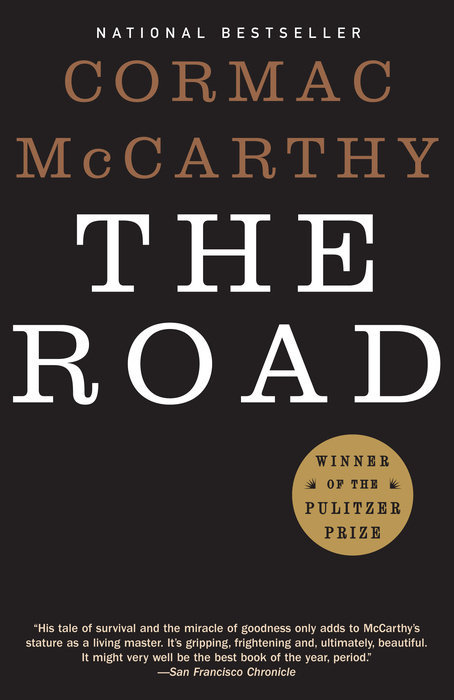



In Memoriam: Cormac McCarthy (1933-2023)
The Road by Cormac McCarthy
A father and his son walk alone through burned America. Nothing moves in the ravaged landscape save the ash on the wind. It is cold enough to crack stones, and when the snow falls it is gray. The sky is dark. Their destination is the coast, although they don’t know what, if anything, awaits them there. They have nothing; just a pistol to defend themselves against the lawless bands that stalk the road, the clothes they are wearing, a cart of scavenged food—and each other.
The Road is the profoundly moving story of a journey. It boldly imagines a future in which no hope remains, but in which the father and his son, “each the other’s world entire,” are sustained by love. Awesome in the totality of its vision, it is an unflinching meditation on the worst and the best that we are capable of: ultimate destructiveness, desperate tenacity, and the tenderness that keeps two people alive in the face of total devastation.
All the Pretty Horses by Cormac McCarthy
All the Pretty Horses tells of young John Grady Cole, the last of a long line of Texas ranchers. Across the border Mexico beckons—beautiful and desolate, rugged and cruelly civilized. With two companions, he sets off on an idyllic, sometimes comic adventure, to a place where dreams are paid for in blood.
This is the first volume in “The Border” trilogy.
The Passenger by Cormac McCarthy
1980, Pass Christian, Mississippi: It is three in the morning when Bobby Western zips the jacket of his wetsuit and plunges from the boat deck into darkness. His divelight illuminates the sunken jet, nine bodies still buckled in their seats, hair floating, eyes devoid of speculation. Missing from the crash site are the pilot’s flightbag, the plane’s black box, and the tenth passenger. But how? A collateral witness to machinations that can only bring him harm, Western is shadowed in body and spirit – by men with badges; by the ghost of his father, inventor of the bomb that melted glass and flesh in Hiroshima; and by his sister, the love and ruin of his soul.
Traversing the American South, from the garrulous bar rooms of New Orleans to an abandoned oil rig off the Florida coast, The Passenger is a breathtaking novel of morality and science, the legacy of sin, and the madness that is human consciousness.
This is the first volume in “The Passenger” series.
No Country for Old Men by Cormac McCarthy
One day, Llewellyn Moss finds a pickup truck surrounded by a bodyguard of dead men. A load of heroin and two million dollars in cash are still in the back. When Moss takes the money, he sets off a chain reaction of catastrophic violence that not even the law–in the person of aging, disillusioned Sheriff Bell–can contain.
As Moss tries to evade his pursuers–in particular a mysterious mastermind who flips coins for human lives–McCarthy simultaneously strips down the American crime novel and broadens its concerns to encompass themes as ancient as the Bible and as bloodily contemporary as this morning’s headlines.
#cormac mccarthy#in memoriam#fiction#Western fiction#literary fiction#Book Recommendations#book recs#Reading Recs#reading recommendations#library books#TBR pile#tbr#tbrpile#to read#Want To Read#Booklr#book tumblr#book blog#library blog
18 notes
·
View notes
Photo
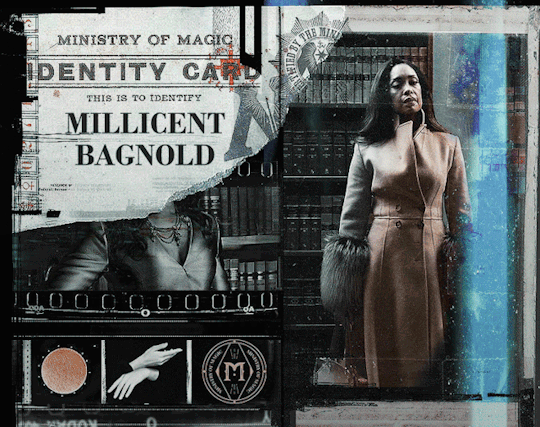
“Oh, Merlin, tell me, does THE LEADER get what she deserves?” She is NEUTRAL, UNPLAYABLE & CLOSED to finding out.“
name → millicent bagnold pronouns → she/her identification → cis-female year of birth → september 1932 - september 1933 face claim → gina torres blood status → pure-blood sexual orientation → pansexual occupation → minister for magic for wizarding britain at the ministry of magic in wizarding london future information → n/a
— she is best described as ;
All the CLASS of an aged IRISH WHISKEY in a CRYSTAL cut glass with the POWER it packs when it touches your THROAT. She is pure STRENGTH, a DEPENDABLE & STURDY figure COLD like a STATUE & just as difficult to push down. She has taken the LAW into her two CAPABLE hands & handles it with CARE & ATTENTION without a single QUIVER. But deep in her eyes is the PAIN & SUFFERING only those who have experience true LOSS will know, though the only eyes to see it are her OWN within a REFLECTION.
— her story starts with ;
Born in a small cottage in Killarney, Millicent had no idea what lay ahead of her. The village was small and was mostly overgrown, a place where sorcerers go to retire. Her parents owned a simple antique bookshop and led simple lives, never leaving the village unless absolutely necessary. Regardless of this quaint upbringing, Millicent’s spirit refused to be contained and leapt at any opportunity that would mean freedom. Ambitious, dedicated and intelligent, she was soon sorted into Ravenclaw in record time when she arrived at Hogwarts, where her fellow housemates would only push her to be better, be greater. At heart, Millicent was a perfectionist, and thus pushed herself beyond her boundaries constantly. She never shied away from a challenge, taking on extra assignments and proving that she was right when she was questioned, even by professors. This, of course, gained her a reputation as a girl that was bossy. Millicent would argue if boys in her class were as forward thinking as her, would they be called the same, or perhaps if she were from sacred twenty-eight families. When she had an opinion she aired it, no matter how much it made the likes of Abraxas Malfoy roll his eyes. Growing up, there had not been much diversity amongst leaders and thus their world reflected the view of those in power.
There were lots of pure-blood men and not just pure-blood men, mostly sacred twenty-eight or adjacent. Millicent realised that in order to be respected like those who had been elected, she’d have to act like one, but try and not lose herself in the process. She began watching those who wielded power and how they managed it, Horace Slughorn, CIRCE GREENGRASS [acquaintance], anyone she deemed successful or someone who influences others around them. She took down notes of how to act like them, how to dress like them. Millicent began holding herself differently and the older she got the more conviction she had in the way that she spoke. Milicent knew she was intelligent, she knew that one day she would be somebody very important and not because of her last name, her blood type or how much money her family had. When she got to the top it would have been because she deserved it, and damn did she know she did. Unlike many young people fresh out of Hogwarts, Millicent was sure of herself and that alone made her excel quickly in her political career. Whilst not making many friends in Hogwarts due to her academic-oriented mindset, she had made a connection with Rutherford Bagnold, a Gryffindor boy who admired her courage and determination.
Both career-orientated, with Millicent working as junior undersecretary to the Minister for Magic and Rutherford in the magical invention industry, they understood one another and respected their desire to climb to the top. During her position as junior undersecretary, Millicent learnt another valuable lesson, that time was valuable and that it should not be wasted on unnecessary questions or conversations. She began to build an encyclopaedic knowledge of the ins and outs of the Ministry and along with her perfectionism, she began to run a tight ship. It wasn’t long until she received a promotion to senior undersecretary. She loved her job, and sure, she was the second-best to a man, but she had gone further than she could have hoped for and already had an impressive influence over the Ministry staff. She attended meetings and press conferences with Harold Minchum, the Minister for Magic at the time and learnt everything she could from him. It was at this point where she finally felt comfortable enough to start a family. It wasn’t long until Rutherford proposed, they had a fairytale wedding that pleased both families present in Ireland. The newly-wed couple moved into a house in Wimbledon and gave birth to their first son, HARRISON BAGNOLD [son].
As much as Millicent loved Harrison, she found being a parent difficult. For the first time in her life she had something other than her work to focus on, even with her husband he looked after himself. Harrison needed her in a way that no one ever had and although she wouldn’t admit it openly other than to Rutherford, Millicent struggled in her early years as a mother, trying to tend to her job and her family and do the best she could at both. Rutherford took the brunt of the parenting when Millicent went back to work when Harrison was two, she longed to be with him more and wondered if he’d have turned out different if she did. But Millicent knew her task and her dream were bigger than Harrison, she wanted to be the Minister for Magic to make the world a better place and that better place she desired a little bit more after her son was born, because she wanted it better for him and for her grandchildren. By the time Millicent had her second child BOOKER BAGNOLD [son], her outlook on parenting had somewhat changed. She was harder on herself with Harrison and harder on him as a result, she wanted him to be perfect and for her parenting to be perfect but when Booker came along she wanted something else, for him to be happy and for their family to be as well.
In free periods she’d take the boys to Quidditch matches and gave Booker the freedom he needed away from Millicent’s work events, the same events that Harrison now attended by choice, standing by his mother’s side, a well-spoken little gentleman that made her very proud. What felt like a couple of years passed quickly and soon Booker was attending Hogwarts too. The couple quickly adapted to their children not being at home again and threw themselves back into work, which quickly paid off for Millicent. She was promptly promoted to Advisor to the Minister for Magic. It was at this point that small cases of missing sorcerers started popping up, a trend formed and Harold Michum decided to allocate an Auror team to investigate the disappearances. What she didn’t know was that this issue would soon become hers. In 1980 Millicent was appointed Minister for Magic. Her carefully orchestrated plan had worked and well placed friendships voted her into power. Harold’s legacy had been that he had run a tight ship, however all those that had known Millicent knew that it had been her ship all along. She had proved all those that had doubted her wrong and more importantly, proved to herself that she was capable of achieving her dreams and more as long as she put her mind to it. In 1980 she became the Minister for Magic, Millicent knew that her time wouldn’t be straight forward, but she didn’t know difficult it could be.
In 1983, Millicent lost her youngest son, forced to watch as his body was fished out of the fountain in her workplace whilst her husband and eldest child screamed and cried with grief. Millicent has never truly recovered from that event. All she wanted to do was retreat into bed with her husband and grieve the loss of her child, but she was the Minister and the people needed her to lead. She had not thought much about creature control until Booker had died, it had never felt like a real issue, though her son had brought it to her attention several times with his position. It was a cruel irony that it was a werewolf that had killed her son, when all he wanted was to protect them. With the help of ALICIA AVERY JONES [colleague] Millicent had the entire weight of the auror’s office thrown behind finding her son’s killer, but people kept going missing, getting attacked or dying. ROSALIE FLINT [person of interest], INES MORENO [person of interest], BENJY FENWICK [person of interest], AMELIA BONES [person of interest] one after the other. Some days it was too much to cope with. Then the alley attacks happened. She knew it wouldn’t make her popular amongst some, it might even cost her some votes, but Millicent knew this was a problem that had gone far enough and now she was going to tackle it the only way she knew how. Head on.
— SHE IS A LEVEL 8 WITCH & READIED FOR WAR ;
#bio rp#bio roleplay#harry potter roleplay#harry potter rpg#gina torres#suits#millicent bagnold#unplayable#unplayable witch#unplayable neutral#m alicia avery jones#m benjy fenwick#m rosalie flint#m ines moreno#m amelia bones#m booker bagnold#m harrison bagnold#m circe greengrass
6 notes
·
View notes
Text
The Son of Kong (1933) : Movietalk # 06

Entry #03 of my Journal of American Giant Monsters, a personal expedition through the Western sectors of Cinematic Monsterland...
If there was ever one opportunity missed in King Kong (1933) it was this: it’s when Jack and Ann are retrieved by the remaining Venture crew holding camp by the great wall’s entrance to the greater island depths. Everyone is relieved their best man and star guest have not fallen victim to the incredible terrors lying beneath that accursed flora – they themselves have not seen the living legend that is Kong (least, not yet), but they have heard plenty about the ghastly fates of their fallen men... not to mention the ghastly, triumphant roars which have echoed in return – so it comes as no surprise that Captain Englehorn is ready to cut their losses and scram as soon as possible, no matter how gravely the voyage home shall be. But who dares lingers at the sacrificial gates but Mr. Carl Denham, looking long into the jungle as if entranced by some dreadful inspiration. Englehorn may be skipper on this cruise but Denham’s the director, so it’s also no surprise everyone stops in their tracks when he exclaims, “What about Kong?”
What about him? If Denham wasn’t before entranced by the business of the seek-and-thrill, he is lapping in manic droves about it now: believe it or not the damned old fool wants to use those gas bombs and put Kong on a leash trailing all the way back to the Big Apple. Not a chance, says Jack, not with him all high and mighty up on that cliff. “Yeah, if he stays there,” retorts Denham. Then he creeps toward the whipped and torn Ann, looming over her as she stands fraught against Jack, staring into her with blazing, menacing eyes. “But we got something he wants!”
This is perhaps the closest the film ever gets to speaking the quiet part out loud, the nearest the film is willing to acknowledge the nature of its expedition and the mocking cruelty that will soon befall Kong – that what we see unfolding before us amidst all the cinematic heights and frights is, in its truest sense, a full-scale tragedy as the result of Man’s ever-unquenchable yearning for exploitation. Denham pushed the Venture out to uncharted waters wanting to grab a piece of the bizarre and the tropical to show back to all the executives and all the gentlemen’s clubs in all the world of America and instead opted to unwillingly drag one big one live to the eyes of thousands upon thousands awaiting way back home on Broadway where the greatest reception the now-captive King would ever garner is a body full of high-powered kernels of lead left over from the Great First War. For a good half of the picture Denham was nothing more than a comical no-nonsense schmuck we all couldn’t help but love – a man we wouldn’t mind seeing in more escalating situations as long as he was around to fall and get around and slip all the way back into even shallower ills – and yet here in this instance we feel the film start to pick at a corner leaf, ready to turn the page on what we have once assumed baked and final to the traits of one “Look Pleasant, Tiger” Carl Denham – until it doesn’t.
How astonishing would it have been ifKing Konghad turned Denham into its true-colored villain on the final lap? How much more resounding would its underlying themes and ideas have been (as varying and distinct as they can be) if the film had pinned all its climactic chaos and destruction and downright murder on the man who was for that moment (no matter how brief or how fleeting) enamored with the draw of the devil that was Greed Itself? For the love of money a kingdom falls, the streets pool thick with blood, and in the midst of all misery there is always someone willing to start it off just because they could; all things seem well and good to the gilded as long as the highway lies bare and narrow from harm, yet for many it’s all too often towards the end when the tunnel gives way to the resulting grisly vistas of their extremes that they’ll know (and they’ll know (for we hope they know)) the doom which lies encompassed... whether it be theirs, or ours.
Fortunately the Legend of King Kong is merely that, a Legend, meaning as the times come and go there will always be someone somewhere to recite that legend further towards the next generation of minds. In the earliest parts of civilization it was oral storytelling that preserved all threads of folklore, and in this ever present age (whatever makeshift generation you might call this) we have found it best – for better or worse – through the remake. Does everybody hate remakes? Yeah, sure, if you believe the consensus; yeah right, more like it (but now’s not the time to divulge any further on the matter). But what’s great about remakes, especially those related to King Kong, is that they allow their inspired creators to find what they will (and do what they will) with all those questions and other curiously left-behind bits and bobs any story is decreed by natural law through the very act of its creation to leave behind (after all if we don’t leave an impression, who or what’s there to be impressed?). The never-addressed dark sides of Carl Denham, for instance? We saw it dealt with in Kong ‘76 through the contemporary form of Fred Wilson, the slimy oil exec who cuts a huge break to host a live corporate circus extravaganza broadcast with the captured Kong acting as unwilling spokes-ape for Petrox Oil down in NYC, and we also saw it further through 2005’s King Kong where we get a Carl Denham who was shown more willing to manipulate and let Darwinian murder sway his way to the big bucks. As for the first yarns of Kong to be spun by its creators on the other hand, it was tricky – real tricky.
It’s known well and good to those versed in Kong-lore that the human trinity of the original story (that being our main characters Ann, Jack and Carl) were really no more than stand-ins for Kong ‘33’s originating dream team – screenwriter Ruth Rose, co-director Ernest B. Schoedsack, and main director and Kong co-creator Merian C. Cooper, respectively – and that much of Kong’s story leaned heavily from the experiences the three of them earned from their very own earlier cinematic endeavors. Before they devised Skull Island out of pure fantasy they were sailing, crawling, sometimes trudging through the jungles and deserts of the World Out There in search of highly potent (and potential) feature film material, shooting real animals up close and personal (and in some cases really shooting them) as they hassled them around from place to place and scene by scene to give way to the scenarios the trio would make for themselves out on the chopping blocks. The moments they were able to capture – whether it be the main pilgrimage across the dry Persian lands of Grass (1925) or the climactic stampede of elephants across the Thailand village of Chang (1927) (which would then bare a precedent to one of King Kong’s many great sequences) – were stunning… oftimes shocking… and many times more incredible... yet they were also quite understandably the kinds of things no one does anymore. Well, some do, of course, though granted they lack the tremendous creativity and aspirations Cooper, Schoedsack and Rose once shared as one (nowadays some are more inclined to sedate exotic animals before “hunting” them down and calling it a weekend); back in those days exploration still meant discovery and adventure, when the only consequence to ever be considered was how well-prepped you will be once you got there and how enriched your worldly perspective shall be when you leave it (if, that is, you do). The driving thrust of conquest was still very much an influence, but it was only in the back of one’s mind or never at all – and why would that matter anyway when there were all these geographic riddles to complete on the maps, all these peculiar names and sights and peoples only shared in words and whispers for you (and only you) to see for yourself? And if you just so happened to be one of those enlightened, well-off few who have Been There and Gone There and Lived To Tell It Like It Is, would it not be a surprise to all if you were to tell it (to spin it) like the yarn it was: to talk of the tribulations of the journey in length, of course, but to say nothing of the joys and wonders and ecstasies of that voyage to the long lost worlds of primitive time? Well... what kind of an adventure was that?
When you catch the colonial tinges of King Kong you can’t unfind them, and though there are indeed many deplorables which can be sourced and made wholesale from its unspoken notions on sex and race – some of which I’d admittedly found myself brushing against on my very first watch a few years back – I instead chose to lean towards embracing its positives which I found to be more than plentiful: though it follows the speculated exploration-hoax-lore turned pulp-horror trope of huge demented primates seeking to rape unsuspecting women (with the noted exception of Kong peeling away some of Ann’s clothing, that is), the film instead chose to make Kong a kindlier, almost innocuous monster who is of some sound mind rather than a completely frothing, ferocious beast, even if much of his ways are indeed as distinct as a human’s (there is still a horror to him but it is all to do with the fact that like all the other giant monsters he will soon become progenitor to, he is Big and Massive (a mastodon, even), and is easily flustered by anything baring teeth or spearheads or bullets, rather than it him holding any predatory malices first); and that the film chose to make us relate to Kong’s moods and motions as our own rather than making him out as just some big bad Dracula to be dispensed with at once, making his last stand on the Empire State not about the triumph and will of modern machinery but instead the massacre of the innocent that it really is (note how that is one of the few scenes after the jump to Skull Island that isn’t accompanied by Max Steiner’s score, how it lets our dread and sadness seep in alongside Kong right to the last burst of violence). Given its originating circumstances, it is quite a surprise how King Kong still resonates as strongly as it does to this day, how full of sorrow it makes us feel every time that Eighth Wonder tumbles his way to the bottom (a send-off many American giant monsters would seem to never be graced with as the decades rolled on, unfortunately). And it is simple to ease our concerns that Carl Denham never gets any immediate karmic reprimands for what he has done right away because, for one thing, the film fades away to black on Kong’s dead body like a pitch-black ender to a hardboiled masterpiece (everything assuming the authorities of New York and beyond are going to settle things straight once and for all as we hit the whipping tail end of the last film reel), and because the film anchored its foundations deep in myth and folklore, the cruxes of reality aren’t as necessary to be obligated to in its telling (“How did they even transport Kong on that flimsy ship of theirs?” How didya think to even ask that in the first place?). It’s make believe, it’s fantasy, but most importantly it’s the movies: they come and go and what happens afterward is often the responsibility of its beholders. But you would also know if you were Merian C. Cooper back in 1933 that movies can get big, they can be a knock-out, that one day you could be a director and the next you could be a head-in-charge executive producer over at RKO with many potential productions in your hands looping by the knots, that somewhere in the very corners of this studio, just in time to collect the dusts of rot, resides the disarrayed fragments of the very world you’d put the will to make into fruition which has landed you this high and mighty position in the first place. If you knew that, then, how would that make you feel (how would that grabya, Caesar)? And, most important things first, what would you even do with all that power?
Maybe, all things considered, what Son of Kong’s really all about is an escape – an escape not just from the ever-nagging consequences of the modern world but an escape from the fantastic, mystical world that was once the great romantic getaway not that long ago: Denham has had an affair with the island and now that things have gotten all hot and heavy back in Metropolis he has found himself reeling all the way back to paradise only to discover he has left behind a son. There could be time for bonding and reconciliation to be had but there isn’t really: the island is as bad as it used to be but worse (now it just might blow up without the slightest indication!) and you gotta understand lil Kiko he’s really gotta go and settle the accounts back home you gotta understand the poor chap’s damn near broke and you know they don’t look at anyone penniless down there unless they’re trying to snatch some apples. Perhaps this is why most writers and directors tend to steer clear away from sequels as a silent rule of thumb: a film or a story is like a dream, a kiss, an obsessive fling that came and went complete, and the only thing a follow-up could ever mean is commitment – and that, for a conqueror, means stagnation at best and failure at worst. How else do you best explain why Son and Island alike are wiped clean off the slate of the Earth and Denham (treasure of the island secure on his person) not only sails back with ease but with the comforts of a newly found dame by his side?
Being relentless and still making all its worth was not too much of a problem back in King Kong (and far from it), but for Son of Kongit always seems like the film just wants to get it over with once the story finally catches up to the island: now every encounter seems spontaneous and random without the slightest bit of rhythm (oooh there’s the Styracosaurus– ooooh nowthere’s a giant bear!). Given the film’s more light-hearted approach it makes since why it would introduce its titular son in a compromising situation as a polar opposite to Kong’s more opposing first appearance, but it also never gives that reveal any kind of build-up/lead-in to make it in anyway more impressionable than it does here where it just happens (even the pterodactyl from The Lost World (1925) who loses its lunch after a single snip had more of a fanfare than this). In Kong there were moments when the music would pull itself back to emphasize more on its action (notably Kong’s famous tussle with the T-Rex as well as the aforementioned fight with the planes), but here there is no lay back on the score whatsoever when it comes to giving Kiko the spotlight – a lot of clashing, a bit of smashing, and plenty more Mickey Mousing than you’d need on an afternoon. It’s strange to say Son of Kong’slead-up to its magic hour (magic thirty minutes, really) is a stronger film than the “serio-comic phantasy” it promised on the promos, but there it is; but how else can you go when you’re hopelessly on second fiddle and the odds are this stacked against you?
Yet not all’s so bad here. The strength of its extended prelude only come to show that even through all of RKO’s harshly strict limitations the creative efforts of Rose and Schoedsack still managed to come out scot-free, the characters (old and new) just as fun and to-the-chase and the directing just as clean and steady as ever. Robert Armstrong is still a fun Carl Denham and (undoubtedly) the best, but he probably wouldn’t’ve have found a softer heart in him as he does here if it weren’t for the addition of Hilda (played by Helen Mack), who manages to show she’s got the chops for the kind of escapades everyone’s about to embark: she’s in ways a performer like Ann Darrow (wherever she may be, poor her) but in reality she’s more like Dorothy Gale with a globetrotting grit, capable of handling herself through parts unknown and willing to charge through hell and back to save others as if the film’s trying to say, “If there was ever a one to tame Denham’s beast, She’s My Girl.” And despite how severely cut for time O’Brien and Company were – well, with just about everything – and unable to hone their crafts further than they were able to do in later projects such as The Last Days of Pompeii (1935)and Mighty Joe Young (1949), they’d made well enough with the time allotted to flex against the expectations of what they’d accomplished before in their past efforts; while intentionally not as well-informed of a fighter as Kong, they were able to let Kiko make up for it by giving him a more expressive personality than even his old man, whether it be him crossing his eyes in a daze and groaning in pain after the giant bear slams him a good one against the rock, or even shortly afterwards when he knocks the bear cold and presents it to Carl and Hilda like a child expressing some successful endeavor to his parents; and while the fights themselves still leave much to be desired – coming off more like a blur despite the camera’s static placements (or rather as the result) – they nonetheless managed to top themselves from a five-to-seven and straight up to eleven with the climactic earthquake destruction sequence, folding, crumbling, and sinking away massive swaths of walk-on sets and island miniatures alike to the heavy thankless waters only Hollywood could provide, coming close to rival even the eruption-wildfire sequence from The Lost World if it weren’t so briskly truncated in the progress. But hey, all this and only clocking under seventy minutes? How could anyone disagree with something like that!
I don’t know; so many questions, too many avenues. I do know the film indeed grants Carl Denham a redemption even if it does at first feel like such an unsatisfying move to make given the original and I am fine with that – sure, why not, everybody loves somebody mending their ways and we love to see it (we really do!) – and I do feel setting him back on the island to meet up with another Kong and have a grand ol’ time together was a great idea – it’s the first and earliest Kong film to have the human characters show enough sympathy for a Kong they are willing to assist them in the progress, though I am still quite weirded out by how firmly it sticks by its one-for-you-one-for-me mentality (“Two good deeds in one day for something that size, we ought to be caught up on our good deeds for a year!”). Yet on top of its fairly teensy limitations and faults more than anything, it’s just that I can’t shake away how it ends, how this – a continuation of a film which ended with a lamenting note for its leading star rather than on its typical side-romance because Jack falling soft for Ann was but a nimble branch of the grander tale that was the journey and death of Kong – decided to end itself instead on a happily-ever-after romance a ship away after yet another Kong has perished. (Another Kong has perished.)He was not murdered – his leg was clamped between a rock and he had no other choice but do one last favor and save Denham from the dragging death Nature and Fate had found best to befall upon him – but damn… taking out the island and Kiko just like that? I don’t know exactly how the reception for this turned out back in ‘33, but I have at least found some ounce of understanding as to why it has often been considered a “cash-out” kind of movie over these past ninety-some years: it is empty not on production value nor its talents but in its closure; in its eyes Carl Denham walks a free man, but that freedom was made on a death no different than the one which brought him into trouble in the first place. To me it’s an ending not far off in feeling as the one to A Man Called Horse (1970), a western about an Englishman being captured and made a pet, a servant, then before long made a warrior (then leader) of a Native American tribe... and that’s perhaps one of the last comparisons anyone wants to make for what is essentially a comedy. It doesn’t feel as queasy as Horse does, mind, but that’s as much as it really offers... yet considering (once again) how insanely rushed its production was, perhaps it’s best to assume this was only an incidental misstep for a film which promised to bring “Laughs! Thrills! Pathos!” on the table for the holidays. Maybe it delivered; then again, maybe it wasn’t enough.
Interestingly Godzilla’s son, Minilla, would fair better on his first outing, embraced by his adopted father to best the waves of an artificially-generated winter, yet that is not to say the Son of Kong would lie dormant in these waters forever. He would make a reappearance in King Kong Lives (1986) and another more recently in Godzilla x Kong: The New Empire (2024) where he is christened the name of Suko and – a very first in all the Kong films –the title of Prince, leading him and the rest of King Kong’s kind from bondage towards some brighter paradise. Ain’t like it used to be, but it’ll do.
#son of kong#the son of kong#ernest b. schoedsack#merian c. cooper#king kong#movies#movie review#consider the following#movietalk#journal of american giant monsters#more to come
0 notes
Text
Meet the Als

(screencap redraw done by me!)
NAME: Alastor Calloway Guillory NICKNAME(S): Calloway, Cal DATE OF BIRTH: April 10, 1898 DATE OF DEATH: Novermber 6, 1933 AGE: 35 (at death), 126 (chronologically) NATIONALITY: American ETHNICITY: mixed (haitian creole & some form of white that he isn’t sure of) HEIGHT: 7’ / 213 cm WEIGHT: 110 pounds / 50 kg OCCUPATION: overlord, radio host, facilities manager of the hazbin hotel, serial killer (in life
Alastor was born on April 10th, 1898, on the outskirts of Cut Off, Louisiana. Sometime in 1916, he made the move to New Orleans before being picked up as a protégé by a man that, at the time, specialized in military radio. In 1922, the first Louisiana commercial station opened up, and as radio began booming in popularity, Alastor became one of its local stars, which allowed him to live his best life.
On the side, however, he was also a budding serial killer. He did’t go after just anyone; instead, he followed an odd moral code that, in essence, told him he could only kill those that were guilty of muder, and only after finding conclusive evidence of this fact. In his eyes, he was righting society’s wrongs, and more often than not he was also the one delivering news of his killings to the public, with no one ever being the wiser for it.
His luck—and, consequently, his life—came to an end on November 6th, 1933, when he was tracked down and shot by deer hunters and their hounds. It was a terrible misunderstanding in which the dogs picked up on the blood trail left behind by Alastor’s victim as he dragged it into the bayou for disposal—and the hunters, seeing their hounds tackling and tearing away at something, assumed it was a deer and took their shot.
When Alastor arrived in Hell, he possessed unimaginable raw power, which was never before seen in a human soul. After getting a handle on this power, he trampled and killed powerful demons who had been in charge for centuries, all while broadcasting his carnage on the radio for everyone in Hell to hear. Other denizens began referring to Alastor as “The Radio Demon”, and he eventually grew powerful enough to rival the Overlords of Hell, but never officially took up the title for himself.
After several decades of “lacking inspiration” and feeling rather aimless, Alastor happened to come across Charlie’s announcement of the up-and-coming Happy Hotel on TV. Finding the idea of a rehabilitated demon absurd (yet entertaining at the same time), he decided to help Charlie run her hotel, if only to watch sinners try and fail to better themselves for his own amusement.


(screencap redraw done by me!)
NAME: Alastor Doucet NICKNAME(S): Frosty DATE OF BIRTH: January 26, 1912 DATE OF DEATH: February 15, 1933 AGE: 21 (at death), 112 (chronologically) NATIONALITY: American ETHNICITY: Unknown HEIGHT: 7’ / 213 cm WEIGHT: 110 pounds / 50 kg OCCUPATION: assistant manager at rosie’s emporium
Alastor, more commonly known as Frosty due to his very blue appearance, grew up in Louisiana with his mother, Audrey Florence Billiot; his father is unknown to him due to being absent for as long as he can remember. The only thing he knows about him is his surname, which he’s taken for himself.
His mother suffered from Munchausen syndrome by proxy (MSP), and as a result she often made Frosty sick so she could garner money, sympathy, and attention. As a result,��Frosty spent most of his life at home with his mother, due to being too weak and sickly to leave. Much of that time was spent in his room, where he would listen to the radio he kept on his windowsill. This was one of his only sources of comfort and entertainment.
Once he became “too old to control,” his mother decided to send him out for firewood during the winter, specifically instructing that he go a certain distance to ensure that he wouldn’t make it back before freezing to death. She got what she wanted.
When Frosty fell into Hell, he panicked. Since he had no control over his newly-found ice magic, he wound up creating a blizzard that spanned the entirety of Pride and wreaked absolute havoc. It was Rosie that found him first, and she managed to calm him down before too much damage was done. After that, she took him under her wing, and he sees her as the mother he never truly had.


(artwork done by me!)
NAME: Alastor NICKNAME(S): Naasháłiini (pronounced nash-a-lee-i-nai) DATE OF BIRTH: Unknown AGE: Unknown; legend claims he’s lived for over 10,000 years NATIONALITY: N/A ETHNICITY: N/A HEIGHT: 12’ / ~366 cm WEIGHT: 500 pounds / ~227 kg OCCUPATION: N/A
The legend of the Wendigo is well-known to the Native American tribes inhabiting North America: a creature born from starvation and greed. Some say these legends were inspired by Alastor.
No one knows where this entity came from, or even how long he’s lived. The Clovis people, who are thought to have arrived in North America between 13,500 and 13,000 years ago, were the first ones to tell tales about Naasháłiini (the word for ‘murderer’ in their language): a being, half man, half deer, that stalked the forests and killed anyone that tread too deep into his territory. They also claimed that, in leaner years, he would even eat those he killed in order to sustain himself, letting his hunger overpower his respect for human life.
In addition, whenever a life is believed to have been claimed by the beast, it’s said that he does so in gruesome ways. He wouldn’t just kill them outright, but instead, he’s thought to have toyed with them: resetting their traps and putting them in paths he knew they would walk, then waiting for them to be caught before gutting them and letting them bleed out so the local wolves would find them, or caving their heads in with a few strong stomps of his hoof. Their screams would be joined in by his cackling laughter, making it clear that he didn’t just kill them for trespassing, but also for sport.
There have only been a handful of sightings, but all of them say the same thing. Alastor is tall and imposing, with blood soaked into his fur and hooves and hands. His human body is littered with scars from the lucky few that have managed to land a hit, but their bones adorn the leather strap he keeps slung around his waist.
What’s most unnerving, however, is not his height, or the blood, or the bones—but his smile. He’s never been seen without one…especially not when he’s in the middle of a new kill.


(artwork done by my friend ckret2!)
NAME: Alastor Baudin NICKNAME(S): Gremlin DATE OF BIRTH: June 9, 1894 DATE OF DEATH: September 22, 1933 AGE: 39 (at death), 130 (chronologically) NATIONALITY: American ETHNICITY: Mixed (Haitian Creole and English) HEIGHT: 5’4" / 164 cm WEIGHT: 90 pounds / 41 kg OCCUPATION: owner of a butcher shop called ‘chop devils’
Not much is known about Alastor’s past, considering he doesn’t talk about it much. What is known is how mischievous and deranged he is, hence his nickname of Gremlin. While he does carry normal cuts of meat such as beef, pork, and chicken, he also highly prizes his cannibalistic cuts, obtained from other demons that have either wronged him, or simply crossed his path at the wrong time.
He also seems to get great enjoyment out of his work, especially when it involves making the cuts themselves. He always keeps his cleaver handy and sharp, ready for chopping at a moment’s notice. His apron, which he wears over his suit most of the time, is permanently stained red with blood.
Despite his murderous appearance and crazy behavior, he can still be sociable.
Sometimes.


(artwork done by borossir!)
NAME: Alastor NICKNAME(S): Sèf (or Sef, no accent necessary) DATE OF BIRTH: Unknown DATE OF DEATH: ?? ?? 1933 AGE: Unknown NATIONALITY: American ETHNICITY: Mixed (Haitian Creole and English) HEIGHT: 7’ / 213 cm WEIGHT: 110 pounds / 50 kg OCCUPATION: overlord, director and head of a porn studio
This version of Alastor essentially takes over Valentino's place in his universe, leading the porn studio and having many demons working under him through porn movies and/or sex working on the streets. Unlike Valentino, Alastor cares about his workers, paying them fairly and ensuring that they're well protected from abuse.


(artwork by Juanmao!)
NAME: Alphonsine NICKNAME(S): Alphy DATE OF BIRTH: Unknown DATE OF DEATH: ?? ?? 1933 AGE: Unknown NATIONALITY: American ETHNICITY: Mixed (Haitian Creole and English) HEIGHT: 6'2" / 189 cm WEIGHT: 90 pounds / 50 kg OCCUPATION: overlord, radio host
I don't have much to say about this one. It's Alastor...but female. The only difference is that she doesn't work at the Hazbin Hotel. She knows of its existence, though.
4 notes
·
View notes
Photo
Alright, it's time for some *crack knuckles* explanations. This is French, I'm French, here we go.
"Une semaine de bonté", "One week of benevolence/A week of kindness", is not actually a "novel" per se. It is a "roman-collage", a "collage-novel", because... well it is mostly told through collages. It was created as part of Max Ernst's surrealist works. More specifically, "Une semaine de bonté" was created when Max Ernst went to see the duchess of Gramont, Maria Ruspoli, in Vigoleno (Italy). He was supposed to stay there for three weeks - during August 1933. And there he had the idea of this project: take illustrations from various books and resources, cut them into pieces, and then stick them together into new scenes to form the collages of the book. There is even a funny anecdote told by another guest of the duchess at the time, Valentine Hugo. One night she woke up hearing a strange, regular, metallic and dry sound - investigating, she discovered it came through Max Ernst's room. She didn't understand yet what this sound was - she only realized later that it was scissors when she went to check the house's library, picked up an old worn-out book (Paradise Lost, illustrated by Gustave Doré) and discovered the pages of the book were full of holes. Erst had cut pieces of the various Doré's engravings.
The "story" of this book, if there is even one, is told through these collages Max Ernst created - 182 collages in total. (There were two more, but they were rejected by Ernst' publishers) There are also the presence of various quotes sometimes slided between the collages - from Paul Eluard, André Breton, Jean Arp or Marcel Schwob. Max Ernst used a LOT of sources to create his collages: massively-sold popular novels, scientific and medical reviews, sales catalogues of the 19th century... He took pieces from so many things left and right that we can't make a full list of his sources, though we did identify some of them (Gustave Doré's engravings for Paradise Lost ; illustrations of Jules Mary's Les Damnées de Paris ; reproductions of Jean-Martin Charcot's medical photographies of women in hospital suffering from "clinical hysteria"...)
The full name of the work is "Une semaine de bonté, ou les sept éléments capitaux" ; "One week of kindness, or the seven capital elements". The latter part of the title is a pun on "the seven deadly sins", called in French "the seven capital sins". (As with all surrealist works, the text of this collage-novel relies a lot on puns and twisted expressions) The reason for this title is because the "novel" is organized in seven sections corresponding to the days of the week. It was planned to be released in the format of seven booklets, each with a different color, each corresponding to a different day of the week, each with an "element" (as in, a recurring symbol) and each with an "example" (understand, a character or a motif/theme recurring throughout the booklet). I say it was "planned" to be as such, because when the booklets were delivered and sold from April to December 1934, the sales ended up shorter than planned, and so the last three days were gathered into one booklet to save money, resulting in five booklets instead of the seven planned. [If I am correct there were only 800 copies of these booklets, since, as with all "art books" of the time, it was a limited edition/limited release]
Here is the content of the five booklets. The purple booklet was for Sunday, its element was "mud" and its example was the "lion of Belfort" statue. The green booklet was for Monday, its element was "water" and its example was also "water". The red booklet was for Tuesday, its element was fire and its example "The court of the dragon"/"The dragon's courtyard". The blue booklet was for Wednesday, its element was "blood" and its example was the character of Oedipus. The final booklet, the yellow booklet, was the one that gathered the three remaining days. Thursday, with its element being "black" and a dual example of "The laugh of the rooster" and "Easter Island". Friday's element was "sight" and its example was "the inside of the sight/the interior of the view". Finally you had Saturday, with its element being "Unknown", and its example "La clé des chants" ("The key of songs", which is a pun on the expression "La clé des champs", the key of fields, pronounced exactly as "The key of songs").
Here is what the original booklets looked like together:

And to give you an example of how Ernst's collage work went, I will let you compare one of the illustrations he used (Alphonse d'Ennery's Martyre ! illustration, 1885)...

... with the collage he created (seventh picture of the Court of the dragon/Tuesday booklet)


Une semaine de bonté (“A Week of Kindness”) a surrealistic novel by Max Ernst
#reblog#surrealism#max ernst#collage#surrealist work#une semaine de bonté#a week of kindness#illustrations#surrealist art#french things
972 notes
·
View notes